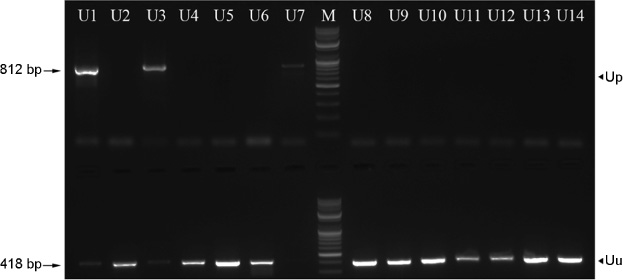J Bacteriol Virol.
2012 Jun;42(2):156-161. 10.4167/jbv.2012.42.2.156.
Genetic Classification and Antimicrobial Resistance of Ureaplasma urealyticum Isolated from Urine
- Affiliations
-
- 1Department of Microbiology and Research Institute for Antimicrobial Resistance, Kosin University College of Medicine, Busan, Korea. microdal@kosin.ac.kr
- KMID: 1717686
- DOI: http://doi.org/10.4167/jbv.2012.42.2.156
Abstract
- Recently, polymerase chain reaction (PCR)-based methods have been used to reclassify Ureaplasma urealyticum into two independent species (spp.), designating U. parvum and U. urealyticum. In the current study, we aim to reclassify U. urealyticum and to analyze the correlation between the presence of a genetic marker and an antibiotic resistance of U. urealyticum. Susceptibility test against tetracycline, levofloxain or moxifloxacin was performed by broth microdilution method. The presence of tet(M) gene and the mutations of quinolone resistance-determining regions (QRDRs) were analyzed by PCR and sequencing. Among fourteen Ureaplasma isolates, three were identified as U. parvum and eleven were identified as U. urealyticum, and this is first report showing that two independent spp. of U. urealyticum isolated from Korean are present. The minimum inhibitory concentration (MIC) ranges for Ureaplasma isolates were as follows: tetracycline 0.25~128 microg/ml, levofloxacin 1~8 microg/ml, and moxifloxacin 0.5~4 microg/ml. The tet(M) determinant was found in 3 among 14 Ureaplasma isolates with tetracycline MIC of >16 microg/ml, suggesting that the presence of the tet(M) determinant is associated with tetracycline resistance. Mutations of gyrA, gyrB, parC, and parE genes in the QRDRs were found in 3 among 14 Ureaplasma isolates, exhibiting only parE gene mutation is associated with fluoroquinolone resistance.
MeSH Terms
Figure
Reference
-
1. Taylor-Robinson D, McCormack WM. The genital mycoplasmas. N Engl J Med. 1980. 302:1003–1010.
Article2. Cassell GH, Waites KB, Watson HL, Crouse DT, Harasawa R. Ureaplasma urealyticum intrauterine infection: role in prematurity and disease in newborns. Clin Microbiol Rev. 1993. 6:69–87.
Article3. Wetmore CM, Manhart LE, Lowens MS, Golden MR, Jensen NL, Astete SG, et al. Ureaplasma urealyticum is associated with nongonococcal urethritis among men with fewer lifetime sexual partners: A case-control study. J Infect Dis. 2011. 204:1274–1282.
Article4. Robertson JA, Stemke GW, Davis JW Jr, Harasawa R, Thirkell D, Kong F, et al. Proposal of Ureaplasma parvum sp. Nov. and emended description of Ureaplasma urealyticum (Shepard et al. 1974) Robertson et al. 2001. Int J Syst Evol Microbiol. 2002. 52:587–597.
Article5. Kong F, James G, Ma Z, Gordon S, Bin W, Gilbert GL. Phylogenetic analysis of Ureaplasma urealyticum --support for the establishment of a new species, Ureaplasma parvum. Int J Syst Bacteriol. 1999. 49:1879–1889.6. Waites KB, Crouse DT, Cassell GH. Therapeutic considerations for Ureaplasma urealyticum infections in neonates. Clin Infect Dis. 1993. 17:Suppl 1. S208–S214.7. Vester B, Douthwaite S. Macrolide resistance conferred by base substitutions in 23S rRNA. Antimicrob Agents Chemother. 2001. 45:1–12.
Article8. Bebear CM, Renaudin H, Charron A, Gruson D, Lefrancois M, Bebear C. In vitro activity of trovafloxacin compared to those of five antimicrobials against mycoplasmas including Mycoplasma hominis and Ureaplasma urealyticum fluoroquinolone-resistant isolates that have been genetically characterized. Antimicrob Agents Chemother. 2000. 44:2557–2560.
Article9. Everett MJ, Jin YF, Ricci V, Piddock LJ. Contributions of individual mechanisms to fluoroquinolone resistance in 36 Escherichia coli strains isolated from humans and animals. Antimicrob Agents Chemother. 1996. 40:2380–2386.
Article10. Hooper DC. Bacterial topoisomerases, anti-topoisomerases, and anti-topoisomerase resistance. Clin Infect Dis. 1998. 27:S54–S63.
Article11. Webber M, Piddock LJ. Quinolone resistance in Escherichia coli. Vet Res. 2001. 32:275–284.12. Roberts MC, Kenny GE. Dissemination of the tetM tetracycline resistance determinant to Ureaplasma urealyticum. Antimicrob Agents Chemother. 1986. 29:350–352.
Article13. Ng LK, Martin I, Alfa M, Mulvey M. Multiplex PCR for the detection of tetracycline resistant genes. Mol Cell Probes. 2001. 15:209–215.
Article14. Bébéar CM, Renaudin H, Charron A, Clerc M, Pereyre S, Bébéar C. DNA gyrase and topoisomerase IV mutations in clinical isolates of Ureaplasma spp. and Mycoplasma hominis resistant to fluoroquinolones. Antimicrob Agents Chemother. 2003. 47:3323–3325.
Article15. Kong F, Ma Z, James G, Gordon S, Gilbert GL. Species identification and subtyping of Ureaplasma parvum and Ureaplasma urealyticum using PCR-based assays. J Clin Microbiol. 2000. 38:1175–1179.
Article16. Brown JT, Roberts MC. Cloning and characterization of tetM gene from a Ureaplasma urealyticum strain. Antimicrob Agents Chemother. 1987. 31:1852–1854.
Article17. Clinical and Laboratory Standards Institute. Performance Standards for Antimicrobial Disk Susceptibility Tests-Tenth Edition: Approved Standard M02-A10. 2009. Wayne, PA, USA: CLSI.18. Akiyama T, Khan AA. Molecular characterization of strains of fluoroquinolone-resistant Salmonella enterica serovar Schwarzengrund carrying multidrug resistance isolated from imported foods. J Antimicrob Chemother. 2012. 67:101–110.
Article19. Zhang W, Wu Y, Yin W, Yu M. Study of isolation of fluoroquinolone-resistant Ureaplasma urealyticum and identification of mutant sites. Chin Med J. 2002. 115:1573–1575.20. Xie X, Zhang J. Trends in the rates of resistance of Ureaplasma urealyticum to antibiotics and identification of the mutation site in the quinolone resistance-determining region in Chinese patients. FEMS Microbiol Lett. 2006. 259:181–186.
Article21. Duffy L, Glass J, Hall G, Avery R, Rackley R, Peterson S, et al. Fluoroquinolone resistance in Ureaplasma parvum in the United States. J Clin Microbiol. 2006. 44:1590–1591.
Article22. Takiff HE, Cimino M, Musso MC, Weisbrod T, Martinez R, Delgado MB, et al. Efflux pump of the proton antiporter family confers low-level fluoroquinolone resistance in Mycobacterium smegmatis. Proc Natl Acad Sci U S A. 1996. 93:362–366.
Article
- Full Text Links
- Actions
-
Cited
- CITED
-
- Close
- Share
- Similar articles
-
- Ureaplasma urealyticum or Ureaplasma parvum: what's the difference?
- Clinical and microbiological study of ureaplasma urealyticum
- A Study of the Isolation of Ureaplasma Urealyticum in Nongonococcal Urethritis
- Prevalence of Ureaplasma Urealyticum in Ovarian or Cervical Cancer
- The Value of Ureaplasma Urealyticum and Chlamydia Trachomatis in Female Urethral Syndrome



